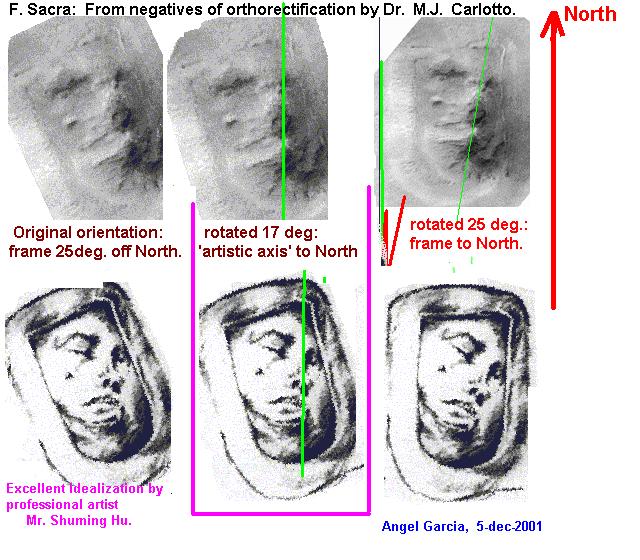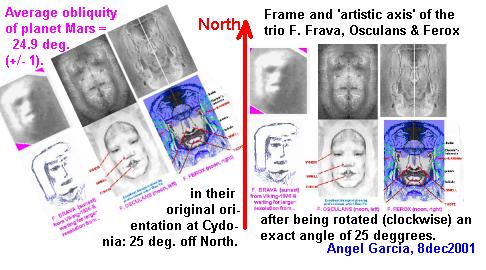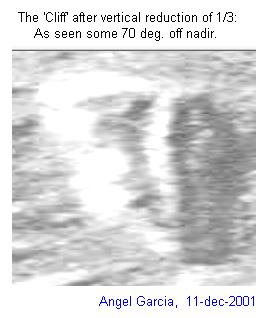|
Simple illustrations which duly summarize the excellent work of Dr. Ward (1992, in "Mars" book) regarding the obliquity of planet Mars. He indicates that his numbers in there cannot be final but preliminary approximations due to many uncertain data which prevent an exact computation of precession, for instance, not far from 173000 years. Thus his assessment of minimal obliquities of around 17 deg. could be off by 2 deg. (I assume) and even larger (he says if some 'resonance' between precession and spiraling of orbital inclination takes (or took in the far past) place. Actually the moonlet Phobos could be acting as moderator to prevent such harmful resonances (Lahoz hints). 
&&&&&&&&&&&&&&&&&&&&&&&&&&&&
The images below show that F. Sacra has indeed the same frame orientation as all the others (F. Brava, F. Osculans and F. Ferox); namely at 25 deg. off North anticlockwise. But, unlike the others, F. Sacra has to be rotated some (17 +/- 2) deg. to set it with 'artistic axis' pointing to North. Rotation of 25 deg. would be excessive as shown. Thus that 'old person', wrapped in blankets, outstandingly describes the low 'obliquity' (some 17 +/- 2) deg. when Mars becomes immersed in deepest ice-ages every 1.3 million years. See above illustrations. 
While F. Sacra needs two different rotations (17 +/- 2; and
25 +/- 1 deg.) to set it up-right), the rest of FM (trio below) has a simple and unique axis which fits within error bar the Ward's obliquity-angle for Mars in the long range time average. These so clear facts describe Mars in its most salient properties regarding Biology (and Human) life. 
Dr. Carlotto has already (nov-2001) studied and published the last NASA/MSSS image of FM (release of may-2001). His article is positively reviewed by Dr. Crater (physicist) in the same first issue of "New Frontiers in Science". These authors go slowly ('piano, piano si va lontano') in their analysis: Carloto is introduced by saying about apparent 'lack of facial features in East side' of FM. That is obviously incorrect because F. Ferox is there with the very best facial features of a macho character in full and well dressed face (including the Darwin's tubercle in its ear); of course the NEGATVE is used for Ferox as for Sacra. Without such elementary coding of 'negatives and split-face' the martian design could never get to the point of compacting FOUR different characters in a single 3-D structure. The Geometry of its frame and probably its 3-D exact shape are (or will be) best assessed by the talented specialist in image processing Dr. Carlotto (engineer). Best regards to both great pioneers Carlotto and Crater. 

R. Hoagland in fig. 10 of his book "The Monuments of Mars" (1987) and M.J. Carlotto in pag. 107 of "Martian Enigmas" (1991), both mention as guess over Viking's images that the line 'Tholus to Cliff' and the stretched face 'Cliff' are tilted some 20 (or 19.5) deg. relative to meridian. In present map of Cydonia (from MGS) we estimate such tilt as closer to 15 +/- 3 deg. The vertical green line through 'Cliff' has been rotated exactly 15 deg. Thus such tilt very likely is identical to that 'artistic axis' of F. Sacra as above shown. Why?... "Cliff" is undoubtedly an encoded 'human face' representing Phobos (TETET-96). Such 'Face' was firstly detected (and reimaged at 70 deg. from nadir) by Dr. Carlotto. Thus, since Phobos is tightly locked with equator of Mars, at minimal martian obliquity we have also minimal tilt of phobian orbit and phobian axis.
Mars and Phobos both suffer simultaneously the same ice-ages. See above 'face Cliff' in our graphic compaction from Viking's image at sunset. |






